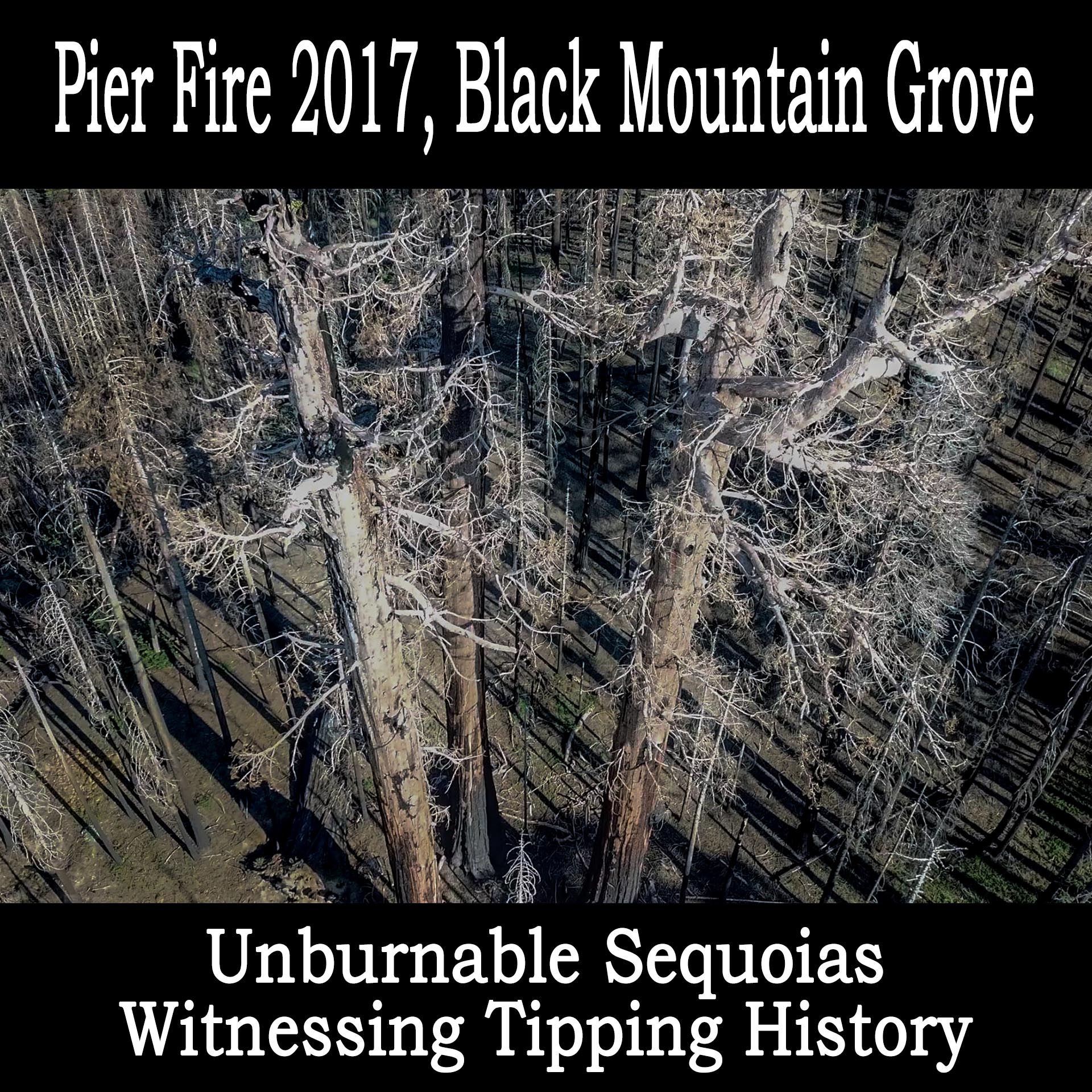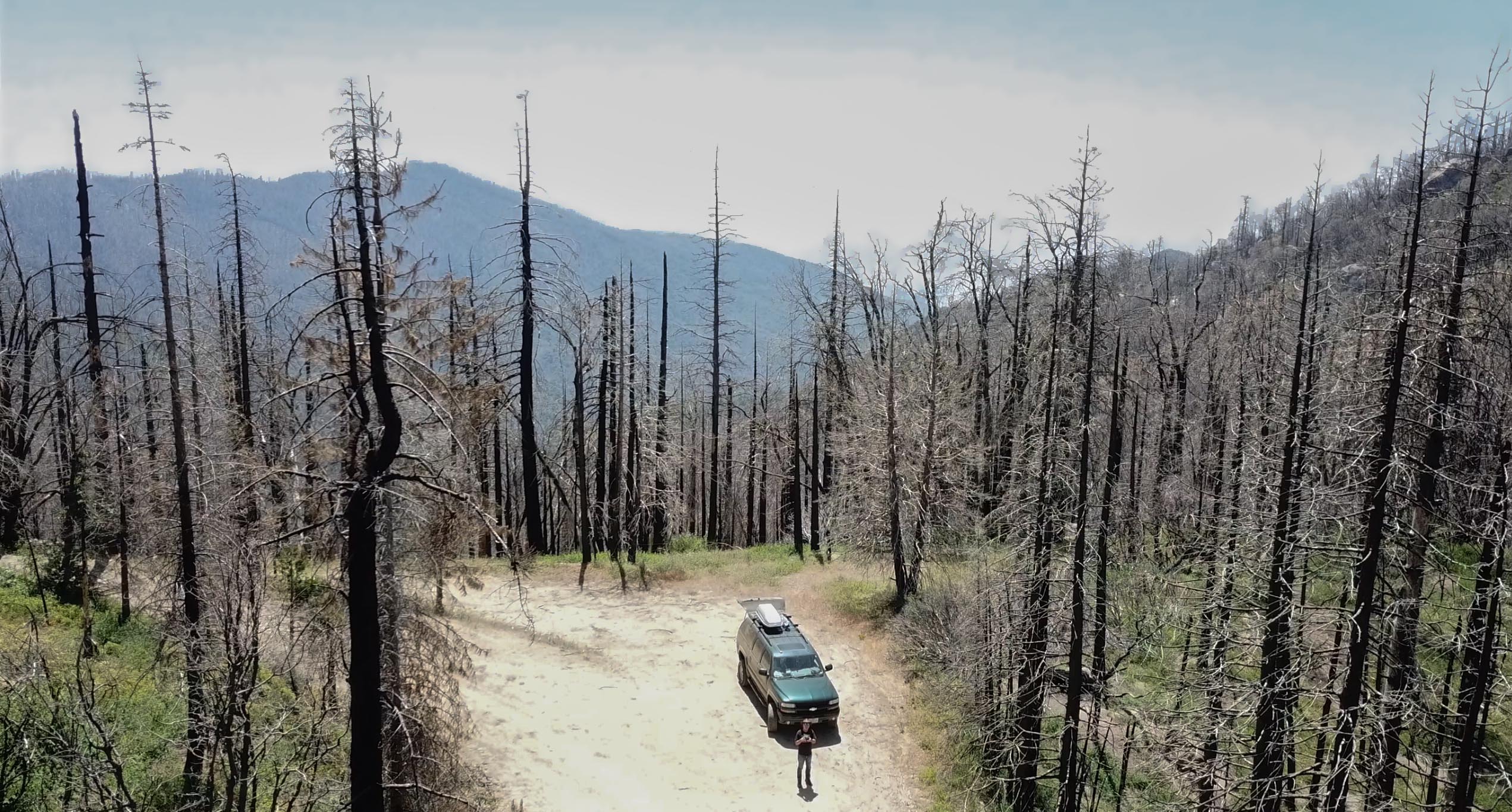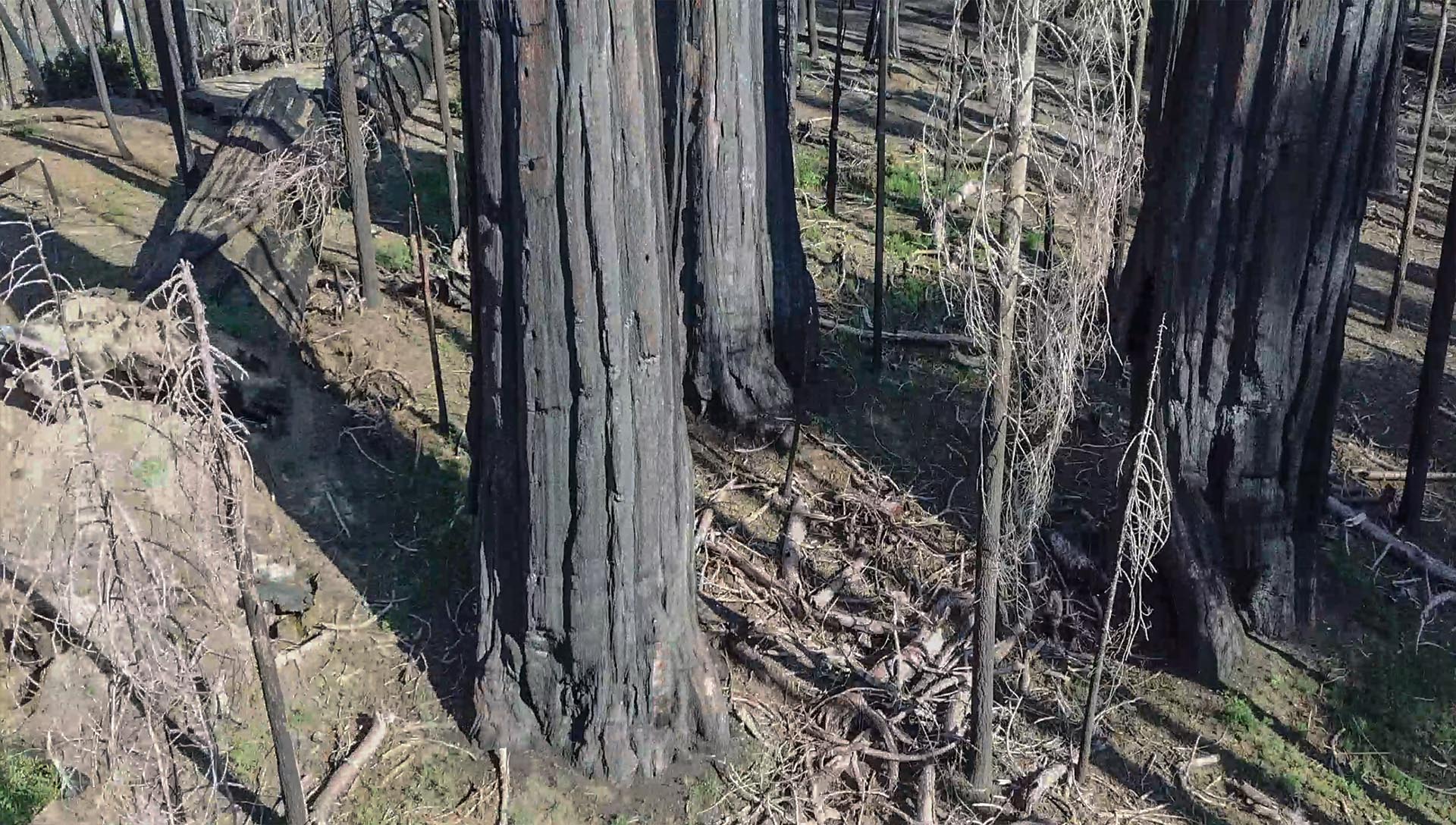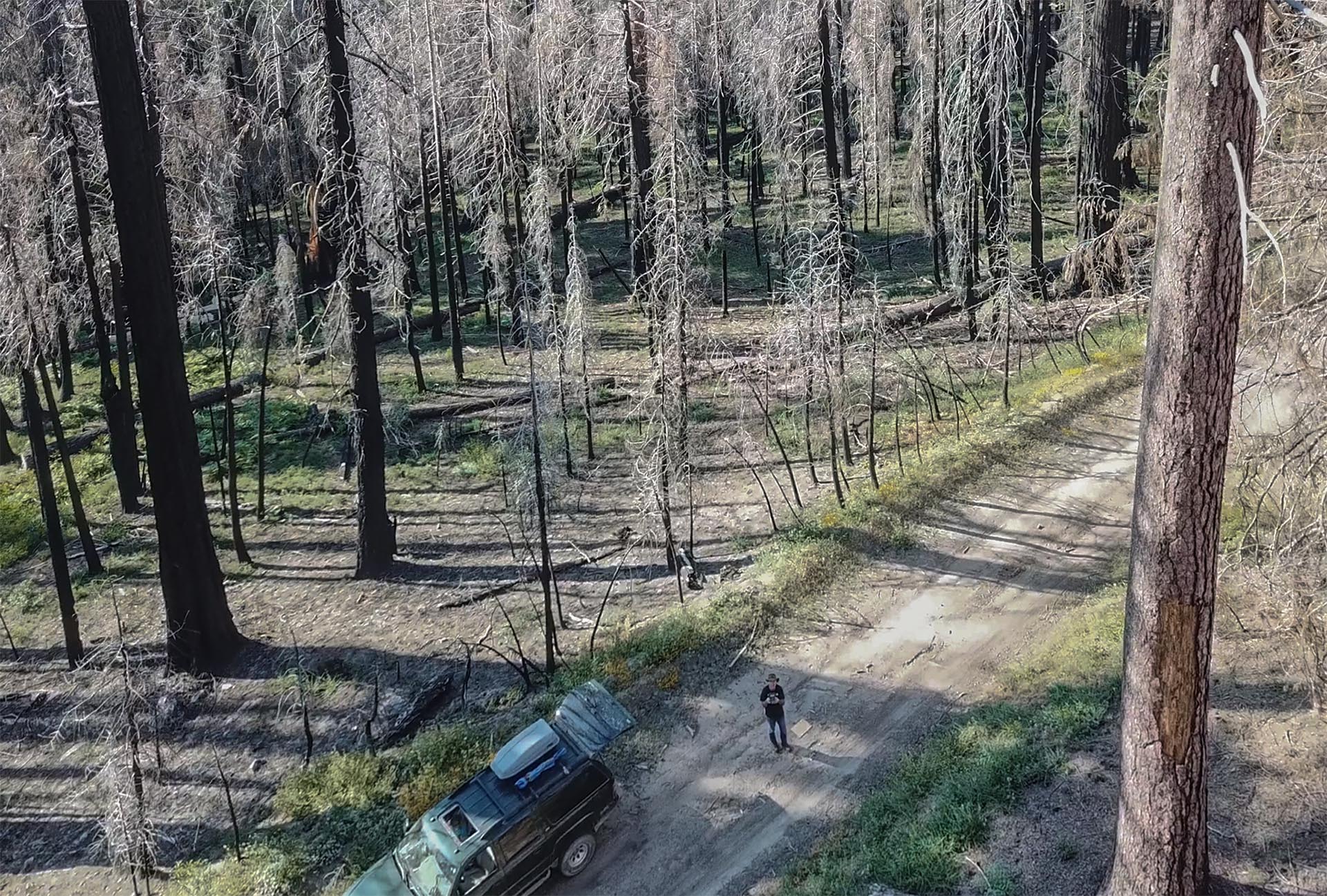
Pier Fire 2017, Black Mountain Grove
Unburnable Sequoias Burned
July 2019, Sequoia National Forest – We had been driving the Pier Fire burn for two days. Two days in the black. We camped at the intersection of two logging roads, parking in the middle of the widest spot, as we had only seen two vehicles.

This was the Black Mountain Grove, east of Nelson Camp. The fire was unusually extreme with little mosaic of lesser burned areas. This fire was one of the first tipping point fires driven by not only excess fuels from fire suppression, but six other climate change-caused extreme fire behavior mechanisms that have emerged since the middle of the twenty-teens: record dry fuels from climate change drought, record low humidity, higher temperature creating easier ignition and more extreme burning, record wind storms, longer drying with earlier spring and later onset of fall conditions, and increased nighttime fire behavior. (1) Because of these six climate change-induced fire enhancing factors, CalFire says fires are now burning 400 degrees hotter. (2)
 The base of the four giants from the cover photo. Note the fallen sequoia on the left.
The base of the four giants from the cover photo. Note the fallen sequoia on the left.
Nearly twenty percent of all sequoias were killed by climate change-caused wildfire in 2020 and 2021. An estimated 12,000 mature giants ended their thousand year reign. (3)
Rocks were split and trees exploded from expanding sap. Towering black spires pointed at the cloudless sky. Few trees had fallen yet, though their looming was ever-concerning.
Pioneer annuals and grasses had sprouted but mostly the black ruled. Very few trees of any kind were resprouting, including sequoias. A third of fires in the West burning since the turn of the century have not regenerated at all and half are regenerating at only half the twentieth century rate. (4)

Driving a burn is not like driving in a forest. The contrast between black and light is confounding. It’s dry. Really dry. The smell of burn is no longer ever-present after two years, but it lurks. The lack of life is usually a sign of rebirth, but our climate’s warming beyond her evolutionary boundaries has put “normal” regeneration on hold.
We were headed out. Our time documenting was over here. The moist coastal redwoods were our next destination; green, lovely, soft, cool, moist, threatened.
A grouping of three burned giants appeared on our right, hidden behind us on our way in. I put the drone up and flew over to the grouping and observed a fourth that had fallen in the apocalypse; a 12-inch lodgepole pine growing on its root ball rode down with the giant.
The view from above was staggering. This natural force, killing these unkillable giants, was in itself a natural thing, though caused by us. It happens every time our climate changes abruptly. The last time could have been as much as 10,000 years ago when Earth warmed out of the last ice age.
The giants were bleached white, not uncommon, a trait of extreme fire behavior. These three torched as the behavior is called. The mature forest of lodgepole pine below the giants had preheated this small grouping of thousand-year old trees and then a gust swept the flames into the tops of the sequoias sending flames one or two-hundred feet skyward above their tops. A tower of flame 400 or 500 feet tall lit the region like it was day but only for a minute, then all needles and small branches were consumed and the giant torch was snuffed leaving the bleached bones of the sequoias towering over the rest of the forest. Fifty-two of the 183 mature sequoias in the Black Mountain Grove were killed. (5)
Sequoia and Kings Canyon National Parks says this about these fires:
“Prior to the recent severe drought, research about giant sequoia mortality suggested that large sequoias typically died by falling or, occasionally, having extensive crown scorch from fire. Death while standing, unrelated to crown scorch, was almost never observed by scientists who had spent decades working in the Sierra Nevada. And while mature giant sequoias did die from fire impacts; that were a relatively rare event, typically the result of many accumulated injuries over their long lives. The hotter drought of 2012-2016 appears to have been a tipping point for giant sequoias and other Sierra Nevada mixed-conifer forests. In hotter droughts, unusually high temperatures worsen the effects of low precipitation, resulting in greater water loss from trees and lower water availability. This is an emerging climate change threat to forests.” (6)
REFERENCES
- Six climate change-caused fire behaviors are now the dominant forcing with increased area and extremeness of wildfire…
Climate Change Caused Wildfires: Columbia University, University of Idaho, Scripps Institution of Oceanography, University of Colorado Boulder… “During 1972–2018, California experienced a fivefold increase in annual burned area, mainly due to more than an eightfold increase in summer forest‐fire extent. Increased summer forest‐fire area very likely occurred due to increased atmospheric aridity caused by warming. Since the early 1970s, warm‐season days warmed by approximately 1.4 °C as part of a centennial warming trend, significantly increasing the atmospheric vapor pressure deficit (VPD). These trends are consistent with anthropogenic trends simulated by climate models. The response of summer forest‐fire area to VPD is exponential, meaning that warming has grown increasingly impactful. Robust interannual relationships between VPD and summer forest‐fire area strongly suggest that nearly all of the increase in summer forest‐fire area during 1972–2018 was driven by increased VPD. Climate change effects on summer wildfire were less evident in nonforested lands. In fall, wind events and delayed onset of winter precipitation are the dominant promoters of wildfire. While these variables did not change much over the past century, background warming and consequent fuel drying is increasingly enhancing the potential for large fall wildfires. Among the many processes important to California’s diverse fire regimes, warming‐driven fuel drying is the clearest link between anthropogenic climate change and increased California wildfire activity to date.”
Williams et al., Observed Impacts of Anthropogenic Climate Change on Wildfire in California, American Geophysical Union, Earth’s Future, August 4, 2019.
https://agupubs.onlinelibrary.wiley.com/doi/epdf/10.1029/2019EF001210
Westerling – large California Wildfires are increasing nonlinearly with drying and earlier onset of spring… “Increases in large wildfires associated with earlier spring snowmelt scale exponentially with changes in moisture deficit, and moisture deficit changes can explain most of the spatial variability in forest wildfire regime response to the timing of spring.”
Westerling, Increasing western US forest wildfire activity, sensitivity to changes in the timing of spring, Philosophical Transactions of the Royal Society B, May 23, 2016, abstract.
http://rstb.royalsocietypublishing.org/content/371/1696/20150178
A paper in the Journal Fire, by a team from the Cooperative Institute for Mesoscale Meteorological Studies… Summary and Conclusions: “most acute fire weather in over two decades… longest duration Santa Ana wind event in the 70-year record… the most extreme drought on record… lowest fuel moisture on record… driest March through December since 1895.”
Nauslar et al., The 2017 North Bay and Southern California Fires, A Case Study, Fire, June 9, 2018.
https://www.mdpi.com/2571-6255/1/1/18/htm - 400 Degrees Hotter… Wildfires are burning 400 degrees F hotter because of drier fuels. “The infernos bellowed by those winds once reached a maximum temperature of 1,700 degrees Fahrenheit, Cal Fire’s Angie Lottes says; now they reach 2,100 degrees, hot enough to turn the silica in the soil into glass.
Wallace-Wells, Los Angeles Fire Season Is Beginning Again. And It Will Never End. A bulletin from our climate future. By David Wallace-Wells, NYMag, May 12, 2019.
http://nymag.com/intelligencer/2019/05/los-angeles-fire-season-will-never-end.html - NPS up to 19 Percent of Sequoias killed by wildfire in 2020 and 2021, up to 12,000 sequoias killed. “This is an emerging climate change threat to forests.” … “Over 85 percent of all giant sequoia grove acreage across the Sierra Nevada has burned in wildfires between 2015 and 2021, compared to only one quarter in the preceding century. Thousands of large giant sequoias (those with trunks 4 feet in diameter or larger) are estimated to have been killed in six recent wildfires (Figure 1), most of those in the 2020 Castle Fire and the 2021 KNP Complex and Windy fires. Based on aerial surveys from a helicopter, fire severity estimates, and sequoia grove maps, 13 to 19 percent of the world’s large sequoias are estimated to have died in the Castle Fire and the KNP Complex and Windy fires combined, or 8,431 to 11,897 trees (Shive et al. 2021, Stephenson and Brigham 2020). Upcoming fieldwork will help scientists determine more precise giant sequoia mortality estimates.”
Caprio, Giant Sequoias Face New Threats, NPS, 2021.
https://www.nps.gov/articles/000/giant-sequoias-face-new-threats.htm - Post-fire regeneration, regrowth, forest recovery – One third of burned forests are not regenerating at all… Conclusion, “Significantly less tree regeneration is occurring after wildfires in the start of 21st century compared to the end of the 20th century, and key drivers of this change were warmer and drier mean climatic conditions. Our findings demonstrate the increased vulnerability of both dry and moist forests to climate-induced regeneration failures following wildfires. The lack of regeneration indicates either substantially longer periods of forest recovery to pre-fire tree densities, or potential shifts to lower density forests or non-forest cover types after 21st-century wildfires… Our results suggest that predicted shifts from forest to non-forested vegetation may be underway, expedited by fire disturbances [and] that short post-fire periods of wetter climate that have favoured tree regeneration in the past may not occur frequently enough to facilitate tree regeneration in the future, across a broad region and multiple forest types in the Rocky Mountains… Our results suggest a high likelihood that future wildfires will facilitate shifts to lower density forest or non-forested states under a warming climate.”
Data… “For sites burned at the end of the 20th century vs. the first decade of the 21st century, the proportion of sites meeting or exceeding pre-fire tree densities (e.g. recruitment threshold of 100%) decreased by nearly half (from 70 to 46%) and the percentage of sites experiencing no post-fire tree regeneration nearly doubled (from 19 to 32%)… This negative relationship demonstrates the potential increased vulnerability and lack of resilience on hotter and drier sites, or of dry forest species, to climate warming… Tree seedlings may establish in response to short-term anomalous wetter periods in the future, but our results highlight that such conditions have become significantly less common since 2000, and they are expected to be less likely in the future… Further, persistent or long-lasting vegetation changes following wildfires have been observed worldwide.”
Stevens-Rumann et al., Evidence for declining forest resilience to wildfires under climate, Ecology Letters, December 12, 2017. (paywall)
Press Release, University of Montana –
https://www.eurekalert.org/pub_releases/2017-12/tuom-sfr121317.php - Castle Fire 2020 and Black Mountain Grove with the Pier Fire 2017… Completely ignores climate change. “In 2017, the Pier fire burned through the Black Mountain Grove on the Sequoia National Forest, and the Railroad fire burned through the Nelder Grove on the Sierra National Forest. In both places, there were significant losses of mature giant sequoia trees. The Save the Redwoods League and the U.S. Forest Service Ecology Program teamed up to monitor giant sequoia losses. They found that in the Nelder Grove, 39 out of the 104 mature sequoias died. In the areas burned at higher severity sampled in the Black Mountain Grove, 52 of the 183 mature sequoias surveyed died. These events raised awareness that even the oldest, largest giant sequoias are vulnerable to high-severity fire.”
Castle Fire, and Pier fire, Impacts on Giant Sequoia National Monument Groves, USFS, 2021.
https://www.fs.usda.gov/detail/sequoia/news-events/?cid=FSEPRD840759 - See reference 3
